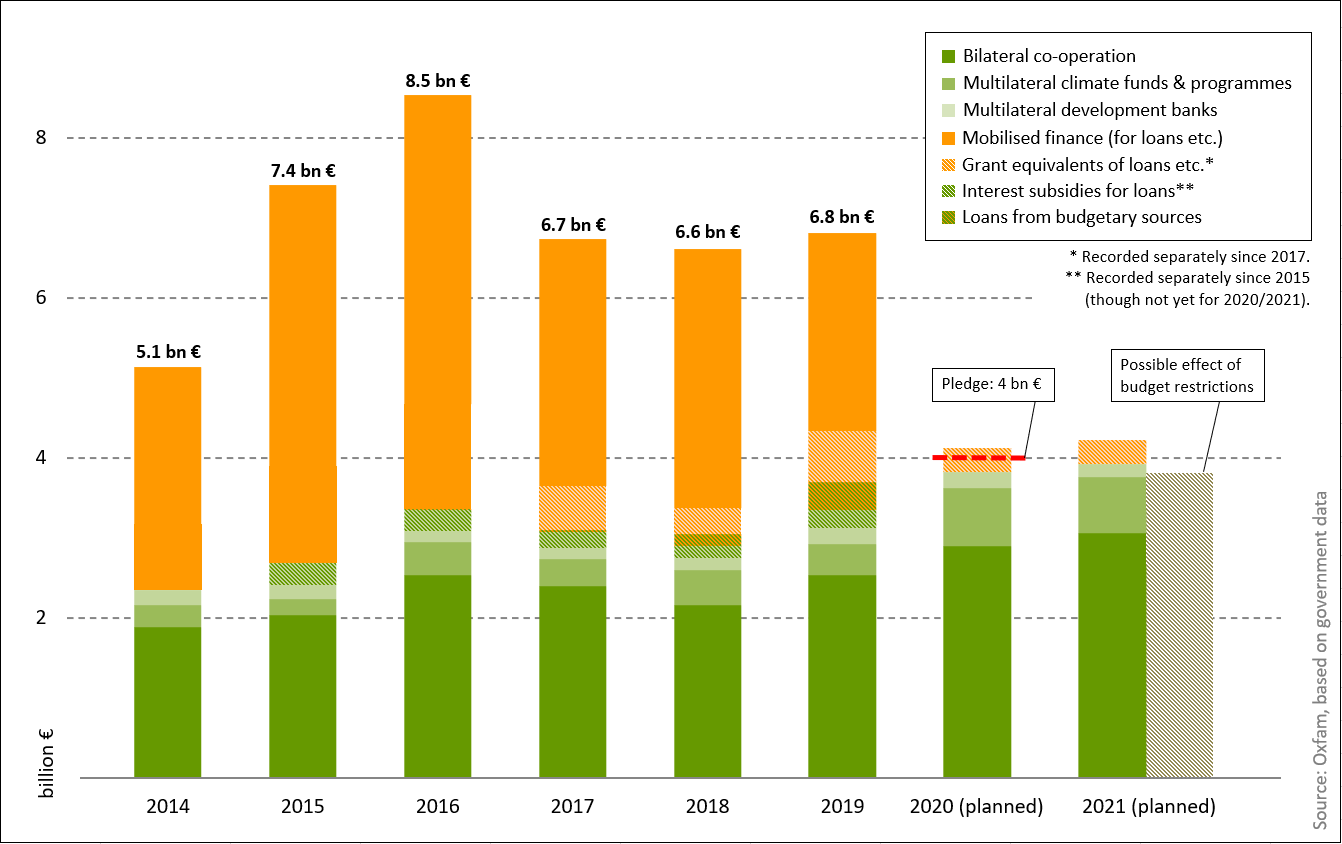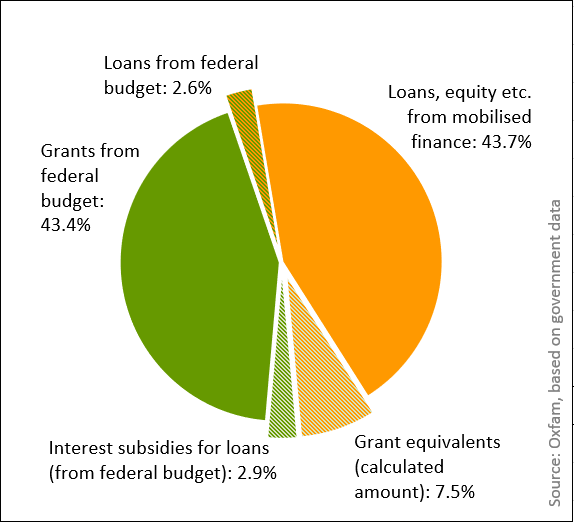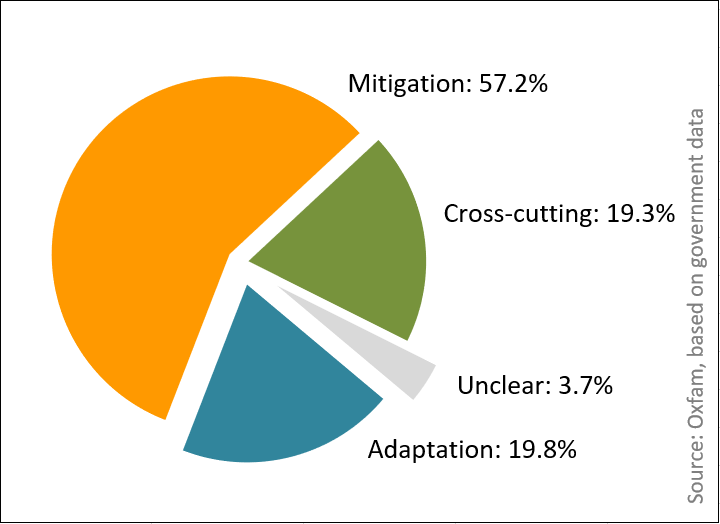German climate finance / 100 billion / Federal budget
German climate finance 2021: Stagnating levels at best, possible decrease
The prospects for German climate finance for 2021 are modest at best. Instead of a significant increase, the German government plans to merely keep past levels. Current restrictions on the budget lines for bilateral development co-operation could even cause a substantial decline – that would be fatal.
At the end of 2020, relatively good news slipped away largely unnoticed (presumably due to the postponement of the UN climate conference COP26 to 2021) In 2019, a year earlier than planned, the federal government met its promise made in 2015 to increase climate finance from budgetary sources to around 4 billion euros annually (albeit only due to the government’s creative accounting method). For 2019, the government reports slightly more than 4.3 billion euros in budgetary resources plus the calculated grant equivalent of concessional loans issues via the German development bank KfW. In addition, finance mobilised on the capital markets amounted to just below 2.5 billion euros that KfW and DEG passed on as loans to developing countries. There are no final numbers available yet for 2020 – though the government has confirmed time and again that the promised level of 4 billion euros (again: budgetary resources plus grant equivalents) would be surpassed, at least slightly.
2021: Stagnating levels or substantial decrease?
For 2021, however, the prospects are rather modest. According to current plans, climate finance is to rise only marginally compared to 2020, which would even mean a decrease compared to the actual figures for 2019 (see Figure 1). And it could get worse: The Bundestag (the German parliament) has partially blocked the key budget lines for development co-operation. If these restrictions are not lifted, this could also affect climate finance in 2021, as a large share of climate finance are sourced from these budget lines. The effect could decrease climate finance in 2021 by (so our estimate) around 400 million euros to levels well below 4 billion euros – a fatal signal to the poorer countries. For the subsequent years 2022 to 2024, the federal government is currently not planning any growth in funds for development co-operation at all, but at best a stabilisation of the 2019 level or a slight decrease, within which climate finance would hardly increase.
Ant his is despite Angela Merkel’s recent announcement at the Climate Ambition Summit at the end of 2020, to provide an additional 500 million euros for climate finance – an announcement that, at closer inspection, inf act includes no additional money at all but consists of amounts that were already budgeted in both 2020 and 2021.
It is crucial that German climate finance increases over the next years. The 100-billion goal set by developed countries in 2009, and on which the German 2020 level of roughly 4 billion euros is oriented, stems from a time when global climate policy was evolving around a 2°C warming limit. Under the Paris Agreement, however, governments committed to pursuing efforts to keep warming at no more than 1.5°C, requiring a significant additional effort compared to 2°C. In addition, experts consider the worsening impacts of the escalating climate crisis and the need to adapt to be substantially larger than estimated in 2009 when the 100-billion goal was set. That means the need for financial assistance of developing countries is growing significantly, especially at the backdrop of the economic repercussions of the corona pandemic and additional crises that worsen the situation in developing countries further, putting their scarce resources under even more pressure.
Composition and usage of German climate finance
It is worth looking at the composition of German climate finance. In the period 2017-2019, less than half (around 43 percent) of the funds were made available as grants (e.g. for bilateral programmes or contributions to multilateral climate funds). The larger share (around 57 percent) came in the form of loans and other non-grant instruments. Under the right circumstances, low-interest, concessional loans can make sense, e.g. in energy projects that generate a return that allow repayment of the loan, but increasing climate risks, the economic consequences of the corona pandemic and other crises are could limit the sustainability of loans in poorer countries in the future, increasing already hefty debt burdens, requiring a refocus on providing grants. To be sure, the actual support inherent in loans consists not in their face value but in their grant equivalent, i.e. the financial advantage for the recipient country compared to a loan at market conditions. It’s recipient countries that make most of the effort, namely by repaying the loan. Yet, the government reports the full face value as climate finance.
When allocating climate finance, the government significantly prioritises mitigation over adaptation, as figure 4 clearly shows. The government usually claims to have achieved a balance between adaptation and mitigation in their allocation of budgetary resources, but when including all climate finance, i.e. including mobilised finance to form loans and other non-grant instruments issues by KfW and DEG, three times more finance goes to mitigation than to adaptation. This is not surprising: mitigation measures are way more attractive for loan financing than adaptation, especially adaptation in critical areas such as food security or protection against extreme climatic events such as drought, storms or flooding. Consequently, the government should ensure substantially increasing shares of adaptation especially from budgetary resources – obviously not at the expense of mitigation support but from an increasing overall budget for international climate finance.
To-dos for 2021
2021 will be a critical year for global climate policy. No later than by the UN climate conference COP26, currently set to take place in Glasgow at the end of the year, all countries should have submitted new, more ambitious climate plans (so-called Nationally Determined Contributions) under the Paris Agreement. At the same time, it is crucial that the recovery from the economic consequences of the corona pandemic contributes and not undermines climate action. Financial assistance for poorer countries is essential for both. On climate finance, the federal government should excel in four areas this year:
First, the current restrictions on the bilateral development co-operation budget lines need to be lifted, so that the development ministry can access the full volume of planned resources, not only for the sake of climate finance but for development co-operation at large, as the economic damages of the corona pandemic in developing countries are becoming increasingly visible. It would be extremely embarrassing for Germany, if the government would be forced to confess to its international partners that climate finance will decrease again, and do so substantially, just one year after 2020, the target year of the 100-billion promise.
As already mentioned above, the government should commit to a significant increase of German climate finance over the next years. Annual climate finance from budgetary sources should be doubled from the current 4 billion euros to at least 8 billion euros by 2025. The next moment to make a related announcement would be the upcoming Petersberg Climate Dialogue. Part of this announcement should be to increase the share of adaptation finance to achieve a better balance between mitigation and adaptation, both for bilateral development co-operation and contributions to multilateral climate funds such as the Least Developed Countries Fund and the Adaptation Fund. Finally, the government should increase the share of grants in overall climate finance, rather than realise future increases via more loans that increase the debt burden for poorer countries.
The government should use upcoming opportunities such as the Petersberg Climate Dialogue but also this year’s G7 and G20 processes, to put pressure on other developed countries to make similar announcements, so COP26 can welcome significant increases of international climate finance 2021-2025. Fittingly, German chancellor Angela Merkel had announced (next to the not-so-impressive 500 million euros pledge mentioned above) that Germany will lead a process among developed countries to discuss further progress on climate finance. So far, no information on this process have been revealed, so it remains to be hoped that Germany will able to report on results well before COP26. Obviously, to be credible in this undertaking, Germany will have to lead by example – see previous point.
Finally, COP26 will see the start of formal negotiations on a new climate finance goal for the period after 2025, building on the 100-billion promise. The German government could take a leading role here if it provides concrete and constructive ideas on the scope and nature of this new target to ongoing discussions and informal exchanges with its international partners. This new target could take the form of a goal matrix with several sub-goals, e.g. separate for the three pillars of global climate co-operation, namely adaptation, mitigation and unavoidable loss & damage, or even qualitative targets such as concerning the removal of existing barriers to accessing existing climate finance or policy change to shift investment flows away from fossil fuels.
Jan Kowalzig, Oxfam








